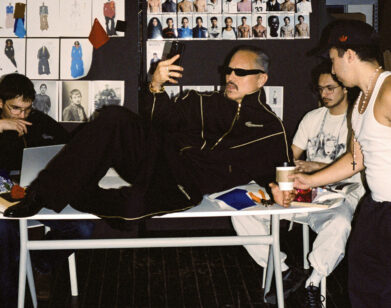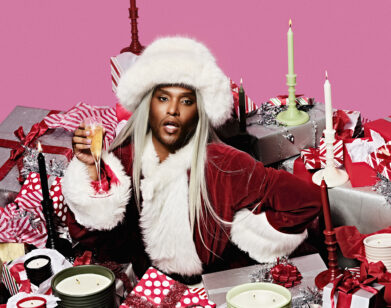The Brooklyn Designer
LEANA ZUNIGA AT ELECTRIC NEST IN BROOKLYN, NEW YORK, DECEMBER, 2014. ALL CLOTHING: ELECTRIC FEATHERS. PHOTOS: CHRISTIAN HÖGSTEDT. HAIR AND MAKEUP: MAHFUD IBRAHIM FOR EXCLUSIVE ARTISTS MANAGEMENT USING NU EVOLUTION AND ORIBE HAIRCARE.
Leana Zuniga came to design her line, Electric Feathers, as a result of a series of cosmic happenstance. After styling film and theater and running the much beloved Alphabet City vintage store La Reina, the Southern California-native and avid traveler launched Electric Feathers in 2007. Based out of Zuniga’s studio in South Williamsburg, Brooklyn, with a storefront aptly titled the Electric Nest where her earthy designs hang alongside a sharply curated selection of objects and curiosities, the brand taps into a certain freedom of dress. Zuniga’s creations contain a mindfulness and versatility that allows garments, such as her signature Infinite Rope dress, to be rolled up, tucked in a knapsack, and unfurled once more on a continent-hopping adventure.
“I’m a behind the scenes person,” Zuniga notes when we meet her at a local watering hole, Marlow & Sons. Her clothes aren’t about fleeting flash; rather, they possess a measured, timeless power with their oversized, diaphanous proportions, pumped-up volume, and richly textured materials (hemp, wools, and raw silks have all figured in, as well as custom knitwear crafted in Peru). Though she shows regularly on the New York Fashion Week docket two seasons a year, Zuniga is focused more on a solid evolution (including some serious expansions in 2015) than reinventing the wheel every six months. Her Spring 2015 collection—which featured breezy one-shouldered frocks, roomy, high-waisted shorts and harem pants, and smart all-in-one jumpsuits in a palette of cream, sage green, and dusty peach—fits the bill for either Palm Springs, Palermo, or whatever destination comes next. We met Zuniga in late December, as she was working on her Fall 2015 collection, just as she was about to jet off to Tulum.
DESIGNER: Leana Zuniga
CURRENTLY BASED: Williamsburg, Brooklyn
SELECTED STOCKISTS: Maryam Nassir Zadeh in New York, Optitude in Tokyo, Totokaelo in Seattle, The Surf Bazaar in Montauk
ROOTS: I was always around clothing. My grandmother was a seamstress. She was from the mountains of Peru and came to this country and made dresses for people and made all our clothes. My father’s an artist. I did costumes for film and theater, which I loved. I started assisting, styling, here in New York. Then I started making clothing—dressing musicians and dancers. I had a tiny, little vintage store for five years. I would travel all over the world to find these gems. A lot of designers would come to the store for inspiration.
THE BEGINNING: I went to India to do Habitat for Humanity, building houses after the tsunami, and after I did that, I went to travel and my friend got sick. I was stuck in this sleepy town, so I got into the tuk-tuk, and I started making clothes. I literally drew the proportions and it turned out really well. I ended up making tons. I brought them back to my [vintage] store and they sold really fast. That was in 2007. I wasn’t trying to be a designer; it just sort of happened. I was actually exploring the idea before I went to India. Kai Kühne from As Four was always really supportive and let me use one of his patternmakers, and I made a couple samples. When I got to India, I was able to experiment. I didn’t get too heavy about it. I think taking those risks and putting yourself out there and not thinking too much about it was a great opportunity to be a fool. I didn’t go to school for this, so I go by instinct. We’re growing constantly at a healthy, slow pace. You want to love what you do; you want to keep loving it. You don’t want to just make numbers.
PHILOSOPHY: When I started making clothes, I wanted to have this basic shape and have the fabric be really comfortable, yet refined, but casual—you could sit on the ground in the grass. I used to go to Wales every year, and travel to Paris or something, and I would want to be able to put the dress on and go somewhere else and change the whole thing. A lot of times, things are already done for you and its recognizable, and it refers to an artist or designer. How about making things that don’t have that reference, that the person who is wearing it punctuates it? I hope [the clothes are] something that allows the person to shine through more than being this thing.
INSPIRATIONS: I’m a traveler. I grew up in the ’80s, which was very much about a fantasy, and dance. I grew up in that world, going out and dancing to hip-hop five or six nights a week. I used to read a lot and get really into it, which is what brought me to New York—Anais Nin and Henry Miller and all those stories. I’d picture myself in a movie scene at the table. I have a pretty vivid imagination. I try to recreate it in a way. Last season was a little bit Death in Venice, 1920s, Deauville. I still have these ideas that the world can be that way.
INFINITE POTENTIAL: I try to make things that I want to wear that are missing. The convertibility is something that just kind of happened, but in high school I used to take my dad’s karate pants and roll them up and turn them out. I always took whatever I could get, because we didn’t have money. I just took things and did things to them. It’s always something I’ve done. I’d take a huge dress, 25 cents at a garage sale, and do something with a safety pin and a scarf. I feel like it’s my instinct to do that. With the Infinite Rope dress, the inspiration was this thing I’d got for 25 cents. Because I love piping, I put piping on it and it became this infinite thing. I always try to get the most potential out of something. I love the idea of using something to its potential. You treasure it too. If you’re traveling, it’s even better. People bring [that dress] back from shoots tied in ways I’ve never even seen. I love it. It makes me happy. It’s interactive, and that makes me feel good. Someone participated and discovered something. [Fashion is] a daily expression of being inspired, and I think that’s important. I always want to be involved in what I wear. I always have to do something to it that makes it feel like it’s me. I want to give someone a canvas that they can interact with. It’s something the lives through the seasons.
For more from the 15 Faces of 2015, click here.







